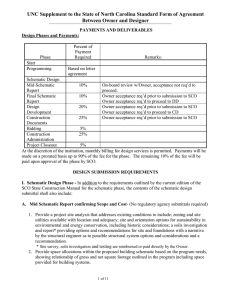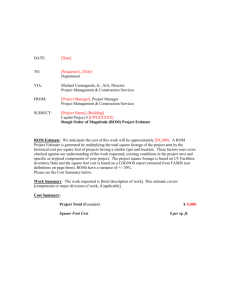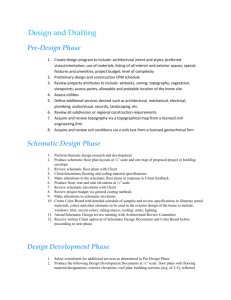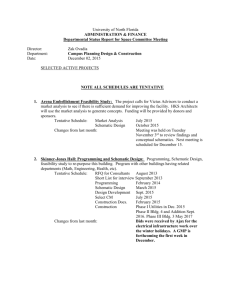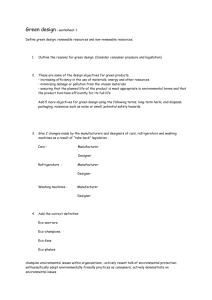design_contract_supplement_8-13
advertisement
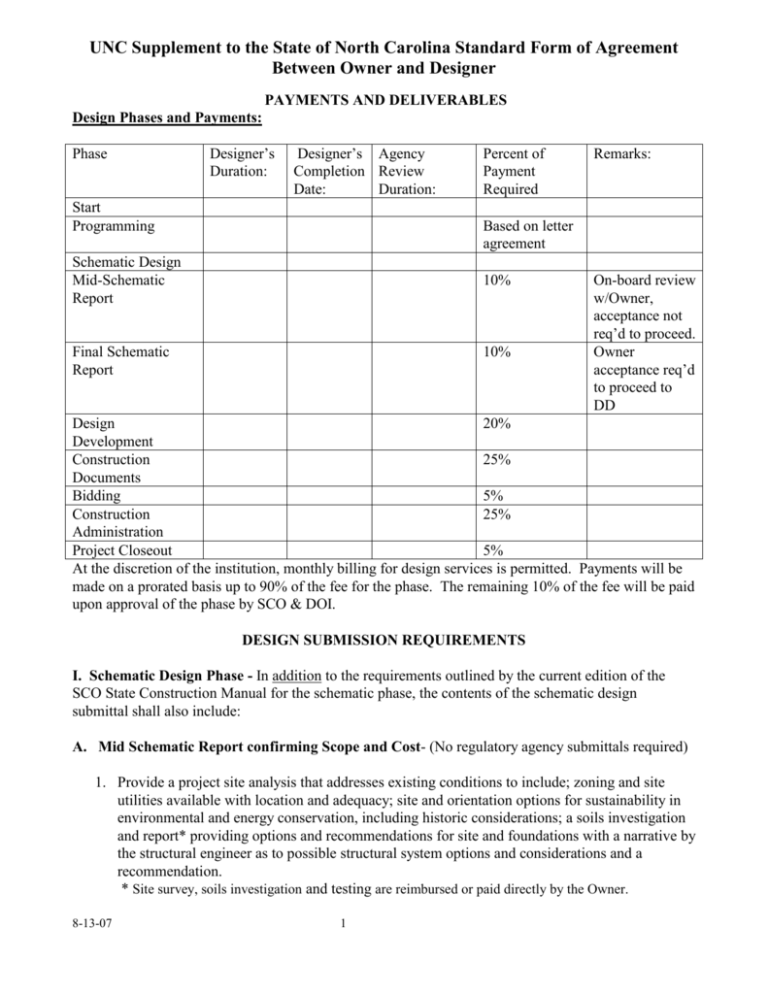
UNC Supplement to the State of North Carolina Standard Form of Agreement Between Owner and Designer PAYMENTS AND DELIVERABLES Design Phases and Payments: Phase Designer’s Duration: Designer’s Agency Completion Review Date: Duration: Start Programming Percent of Payment Required Remarks: Based on letter agreement Schematic Design Mid-Schematic Report 10% Final Schematic Report 10% On-board review w/Owner, acceptance not req’d to proceed. Owner acceptance req’d to proceed to DD Design 20% Development Construction 25% Documents Bidding 5% Construction 25% Administration Project Closeout 5% At the discretion of the institution, monthly billing for design services is permitted. Payments will be made on a prorated basis up to 90% of the fee for the phase. The remaining 10% of the fee will be paid upon approval of the phase by SCO & DOI. DESIGN SUBMISSION REQUIREMENTS I. Schematic Design Phase - In addition to the requirements outlined by the current edition of the SCO State Construction Manual for the schematic phase, the contents of the schematic design submittal shall also include: A. Mid Schematic Report confirming Scope and Cost- (No regulatory agency submittals required) 1. Provide a project site analysis that addresses existing conditions to include; zoning and site utilities available with location and adequacy; site and orientation options for sustainability in environmental and energy conservation, including historic considerations; a soils investigation and report* providing options and recommendations for site and foundations with a narrative by the structural engineer as to possible structural system options and considerations and a recommendation. * Site survey, soils investigation and testing are reimbursed or paid directly by the Owner. 8-13-07 1 UNC Supplement to the State of North Carolina Standard Form of Agreement Between Owner and Designer 2. Provide space allocations within the proposed building schematic based on the program needs, showing relationship of gross and net square footage outlined in the program including space provided for building systems. 3. Provide a summary of ‘required’ and ‘optional’ building areas and features with cost opinions provided for each. Recommend specific features and areas for inclusion in the project scope, within the project funds available. . 4. Existing Buildings: Provide a summary of code requirements related to existing buildings. Provide an analysis of cost for accessibility upgrades. 5. Suggest primary building systems options recommended for detailed life cycle cost analysis, for approval. Explain the rationale for the choices recommended. 6. Describe other building systems being considered for inclusion in the design, and rationales for each of the options. 7. Present clear summary and recommendations for building features, functions, and systems to be included in the project scope, within the funds available. Owner will choose from these recommendations. 8. Review of emergency systems and requirements: Emergency power, fire pump etc. 9. Identify pending decisions or choices by the Owner which have the potential to substantially impact the project scope or schedule. Provide an initial opinion of the potential cost and schedule impact of each item, and identify the next action, party responsible, and due date for resolving the issue. Mid-Schematic approval constitutes an explicit acceptance of responsibility for timely decisions by the Owner and Designer on the critical decisions identified. 10. List regulatory reviews, zoning, and code interpretations or implications applicable to proposed design, as well as permits that will be required. (See “Code Related Requirements” section.) B. Final Schematic Design Submission- (Submit to regulatory agencies as required.) 1. Life cycle cost analysis (LCCA) of primary systems. Include clear LCCA recommendations for primary energy using systems. Recommendations shall be included for each of the following: a. building envelope configuration and construction, including elevations, orientation, and glazing. b. primary heating energy, cooling energy, and electrical power sources c. interior lighting systems d. HVAC systems e. Domestic water heating systems 2. Provide Floor Plans at 1/8” or ¼” per ft. as appropriate to the project considering service space for MEP systems. 3. Provide typical wall sections at large scale, in sufficient detail to determine thermal performance. 4. Provide draft outline specifications for all divisions identifying major products and components proposed for inclusion. 5. Provide a primary building elevation noting materials and areas. 6. Large scale building sections noting systems, clearances, and floor-to-floor height presumptions. Include section at typical confluence points where major building components intersect. 7. Provide schematic representations (flow diagrams or riser diagrams) for Mechanical, Electrical, and Plumbing main systems. Provide general arrangement floor plans to scale, which locate 8-13-07 2 UNC Supplement to the State of North Carolina Standard Form of Agreement Between Owner and Designer major equipment, based on initial size estimate. Identify point of connections for storm sewer, sanitary sewer, electrical, chilled water and steam. 8. Provide preliminary structural framing plan with preliminary sizes of main structural members. 9. Provide, with the project budget summary, a cost opinion, segregated by CSI division. Clearly identify the scope and feature options that are recommended to comply with the available project funds. In the case of Construction Manager @Risk projects, Designer shall assist the CM in the preparation of the cost estimates by providing available project scope documentation, while preparation of the Schematic cost opinion is the responsibility of the CM @ Risk. This is to ensure that the CM at Risk and Designer align scope and budget at the SD stage, but does not relieve either of the requirement for separate estimates as required at subsequent design stages. Final Schematic report shall outline project decisions on soils, foundations and structural system, PME systems descriptions. A comparative space use summary shall be provided, indicating any deviations from the architectural program needed to assure that the project scope conforms to the project funds available. 10. Code compliance report including baseline code related information, using the code compliance form required by DOI (Building Code Summary). C. Responsibility for Budget and Scope Reconciliation Final Schematic Phase approval by Owner reconciles the project scope with the budget by making choices put forward by the Designer. Any substantive changes in the project scope, schedule, or budget which are required by the Owner after Final Schematic approval constitute a change in the Design Agreement scope. A fully executed amendment to the Design Agreement addressing the impact of post Schematic scope changes is required before proceeding with further design phases. II. Design Development Phase - In addition to the requirements outlined by current edition of the SCO Construction Manual for the design development phase, the contents of the design development submittal include: A. Architectural/Civil/Structural – Site Plans and Details 1. Provide site plans at a scale appropriate to indicate the site work and associated utility connections. 2. Provide grading plans separate from the building site plan indicating all proposed site improvements. B. Architectural/Civil/Structural – Floor Plans and Elevations 1. Floor plans shall be drawn at a minimum scale of 1/8” = 1’- 0” with toilet areas and other areas of the building requiring greater detail drawn at 1/4”=l ‘-0” unless otherwise called for in these documents. Prepare a preliminary door schedule showing basic materials. 2. Prepare a set of code compliance floor plans indicating all fire rated construction, exit locations, travel distances, and exit capacities. 3. Elevations: Provide 1/8” scale elevations for all sides of the building exterior. Provide ¼” scale elevations for interior spaces and conditions requiring greater detail. 4. Roof Plans: Provide 1/8” scale roof plans showing all components and identify all roof detail locations. 5. Reflected Ceiling Plans: Provide 1/8” scale reflected ceiling plans showing lighting. 8-13-07 3 UNC Supplement to the State of North Carolina Standard Form of Agreement Between Owner and Designer C. Architectural/Civil/Structural Details - Include typical and key details for the following (This is not intended to be an exhaustive set of details.): 1. Exterior walls and parapets. 2. Sections through the building. 3. Special building conditions. 4. Roof penthouse sections and details. 5. Interior partition types, identifying rated partitions. 6. Final structural framing plan. 7. Column and footing schedules. D. Mechanical/Electrical/Plumbing (MEP) Specifications - Include an initial draft of technical specifications prepared in CSI/MasterFormat 1995 or 2004 numbers and titles. Edited short or long version specifications may be used. All sections required for the project shall be edited and included as part of this submittal. MEP edited sections shall include, but are not limited to the following: HVAC controls, commissioning, fire protection (including sprinklers and alarm systems), panels, switch boards, transformers, and sequence of construction. E. MEP Floor Plans and Elevations 1. Floor plans shall be drawn at the scale of the architectural drawings unless otherwise called for in these documents. All piping, with sizes, shall be shown. All ductwork mains, drawn as double line ductwork with sizes, shall be shown. All valves and hydronic accessories shall be shown. All sprinkler piping mains, sizing, valving, and heads shall be shown. Plans shall identify all fire-rated construction and indicate whether fire partition, fire barrier, or fire wall as defined by code. Plenums shall also be identified. Fire ratings will be shown on all plans (P,M,E) to ensure that contractors will know how to properly protect penetrations. 2. Enlarged Scale Plans: Printed 1/4” scale plans are required for the mechanical rooms, penthouse, roof equipment, computer, printer and telephone equipment rooms. The plans shall show the location of all equipment, based on actual sizes of final equipment selected. (FINAL plans are schematic documents, NOT ‘shop drawings’ drawn to “Exact” dimensions.) 3. Sections: Printed 1/4” scale sectional views are required for the penthouse, mechanical rooms, roof equipment and telephone rooms. Main mechanical rooms shall have sufficient sectional elevations included to confirm that proposed components will fit the space. F. MEP Details - Include schematic diagrams showing all control, monitoring, and isolation devices for the following: 1. Boilers and associated piping 2. Chillers and associated piping 3. Domestic hot water heater or heat exchangers and associated piping 4. Main air handlers (ductwork and piping) 5. Building sprinkler control valve and fire department connections 6. Fire Pump G. Preliminary MEP Equipment Schedules 1. Boilers 2. Chillers 3. Air handlers 8-13-07 4 UNC Supplement to the State of North Carolina Standard Form of Agreement Between Owner and Designer 4. Pumps 5. Other equipment that is project specific H. Electrical – Floor Plans 1. Floor plans shall be drawn at a scale of 1/8” = 1’ unless otherwise called for. Three separate floor plans shall be prepared for each floor. Provide one plan each for lighting, power, and signal - communications systems. 2. Lighting Floor Plans: Plans will show locations of all lighting and exit lighting fixtures. Circuiting will be shown diagrammatically to demonstrate branch circuiting and the switching arrangement. Homeruns will be shown for each plan. The plans will show locations of required disconnect switches, motor starters, and related control equipment, shown to scale, based on final equipment selections (required, but not at this stage). Show the routing of all feeders to panel boards and load centers. 3. Signal - Communications System Floor Plans: Plans will show all signal and communications system devices. Each telephone and computer outlet shall be shown, including devices installed in partition systems which are provided by others. The floor plans shall show all signal system raceway systems unless the raceways can be better shown in riser diagram form. The floor plans shall show the location of all fire alarm system devices. 4. Enlarged Scale Floor Plans: 1/4” scale floor plans are required for the electrical and telephone service rooms, and electrical closets and communications closets. The plans will show the location of all equipment within the room, drawn to scale, based on final equipment selections. I. Electrical Riser Diagrams/Single Line Diagrams 1. Signal Riser Diagrams: Riser diagrams are required for all systems shown on the Signal Communications System floor plans. Riser diagrams shall show each device in the system, with the devices labeled to coincide with the floor plans. Riser diagrams shall show the system raceways, including sleeves. Where cabling is provided by others, cable information is not required on the riser, except to indicate that cable is provided by others. The riser diagram must demonstrate that cable installation is possible. 2. Power Single Line Diagram: Provide a single line diagram for the entire electrical distribution system from the primary service to the load centers - including: a. Verification of load conditions with owner. [This requires a level of detailed knowledge of the primary distribution system that is not usually appropriate for the building design engineers to have, and thus relies on owner-provided information.] b. Short circuit ratings of new primary system devices. c. Each switchboard and panel board in the system. Show the protective devices in each panel board to show protection for each feeder. d. Show each load center including the main protective devices in each load center. e. Prepare the single line diagram in a riser form to show the location of the equipment. f. Emergency Power System 3. Power Riser Diagram: The single line diagram required above will also serve as the power riser diagram. 8-13-07 5 UNC Supplement to the State of North Carolina Standard Form of Agreement Between Owner and Designer J. Electrical Details - Include details for the following: 1. Service grounding detail. 2. Service layout - Show the proposed layout of the transformer/service room, drawn to scale, based on final equipment selections. K. Electrical Panel Schedules - Include panel schedules for each panel board and switchboard. Panel schedules will include the following information: 1. Surface or flush mounted. 2. Voltage, phase, bus size and number of wires, 3. Circuit breaker components, poles, frame, and trip setting. 4. Indicate where specific purpose circuit breakers will be installed. 5. Frame size and number of poles for future circuit breakers. 6. Panel board short circuit rating. 7. Load served. Include name or identification of equipment load served. Panelboard schedules do not have room to show locations, except room nos., which change right up to CD submittal. L. Life Cycle Cost Analysis should be refined and updated as appropriate. III. Construction Documents - Submission materials are consistent with those listed under design development but generally in greater detail. In addition to the requirements outlined by SCO Construction Manual for the construction documents phase, the contents of the construction document submittal include: A. Site Plans and Details 1. Provide site related detail drawings. 2. Provide site drawing to address staging areas, pedestrian and vehicular traffic during construction, including accessible routes as applicable. B. Floor Plans and Elevations 1. Reflected Ceiling Plans: Provide 1/8” scale reflected ceiling plans showing sprinkler, and mechanical items for coordination in addition to lighting. C. Details - Include typical details for the following (in addition to those items listed under DD’s): 1. Loading areas and overhangs 2. Roof flashing conditions 3. Fireproofing schedules and details 4. Trench detail for each underground conduit installation. Show number and size of conduits, concrete requirements, conduit depth, trench bedding and back-fill requirements. D. Life Cycle Cost Analysis – Include final update. CODE RELATED REQUIREMENTS 1. The building must comply with all applicable zoning regulations. 2. The building must comply with NC Department of Environment and Natural Resources (DENR) regulations. 8-13-07 6 UNC Supplement to the State of North Carolina Standard Form of Agreement Between Owner and Designer 3. The Designer is responsible for obtaining all Federal, State and local approvals or assisting the owner and contractors in obtaining as appropriate. 4. Design compliance with codes is a statutory requirement of all registered professionals in NC. 8-13-07 7
